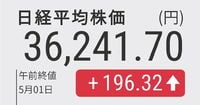Murata Manufacturing Co., Ltd. (Ticker: 6981) has forecasted a decline in both revenue and profit for the fiscal year ending in March 2026. The company anticipates that while demand for artificial intelligence (AI) servers and components for electric vehicles (EVs) is on the rise, the demand for smartphone-related products is decreasing, resulting in an overall revenue drop. This outlook is compounded by the strengthening of the yen against the dollar, which has been projected at an exchange rate of 1 dollar to 140 yen.
According to the company, profit margins are expected to be squeezed due to a decline in product prices and rising personnel costs. This forecast reflects the broader challenges facing the technology and manufacturing sectors, particularly as consumer preferences shift and economic conditions fluctuate.
In a related development in the Tokyo stock market, the Nikkei average stock price saw a notable increase on the afternoon of May 1, 2025. The index rose significantly, with an increase that temporarily exceeded 400 yen at one point during the trading session. Analysts attribute this rise to a perception that additional interest rate hikes by the Bank of Japan are unlikely in the near future, which has led to a weaker yen in the foreign exchange market. The yen's exchange rate against the dollar weakened, briefly reaching 1 dollar to 144 yen.
This expectation of improved export earnings has spurred strong buying interest in automotive stocks, particularly for companies like Toyota Motor. The morning closing price for the Nikkei average was recorded at 36,241.70 yen, reflecting an increase of 196 yen and 32 sen, or 0.54%, compared to the previous day.
As the market reacts to these economic indicators, investors are closely monitoring the performance of key sectors, including technology and automotive, to gauge the potential impact on future earnings and growth. Companies like Murata Manufacturing are at the forefront of this scrutiny, particularly as they navigate the complexities of supply chain dynamics and shifting consumer demands.
The dual narrative of Murata Manufacturing's forecast and the rising stock prices in the Tokyo market underscores the interconnectedness of global economic factors. While the company faces headwinds in specific product categories, the overall market sentiment appears cautiously optimistic, buoyed by expectations of stronger export performance and a favorable exchange rate environment for exporters.
In summary, Murata Manufacturing's projections highlight the challenges of adapting to changing market conditions, particularly in the smartphone sector, while the broader stock market reflects a more positive outlook driven by expectations of improved earnings in the automotive industry. As these trends unfold, stakeholders in both the technology and automotive sectors will be keenly observing how these dynamics play out in the coming months.





